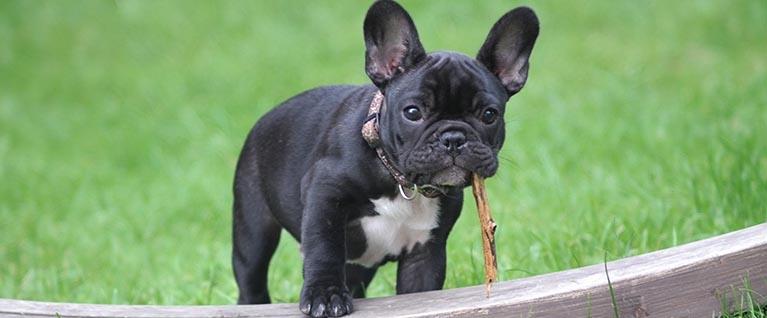We drove 16 hours roundtrip between winter snow and ice storms to pick up our 9 week old puppy. Like most puppies that age, he was a roly poly ball of fur clumsily playing and exploring his environment. So cute. So innocent. So fun.
My only training agenda was to have a pocket full of kibble to reinforce eliminating outside and to build positive associations with anything he may have been unsure about on his first big journey. (Read more about puppy socialization here). Mostly though, I was focused on taking in the novelty of this new soft, little fuzzball, and getting him and our family home safely.
Yet, from the first moment we set his little paws on the ground, he was on an adventure: trying to lick salt off the sidewalk, chew the wood chips in the grass, eat the mud balls in the ice melt, and sometimes just STOP to take in this big beautiful new world. It was apparent that I needed to teach him something. Immediately!
20 years ago I probably would’ve responded to the above exploring by spouting a firm, “No.” “Eh-eh.” Or “Hey!” to startle my pup and stop his dangerous salt, mud and woodchip consumption. I may have even pulled him away from whatever it was he was doing. But now, I know there’s a better way to intervene when my dog is engaging in potentially dangerous or annoying behaviors.
Remember, most of the things we deem inappropriate for our pooch are completely normal and developmentally appropriate for a canine. Exploring and interacting is exactly what they need to facilitate growth into a well-rounded adult. Bellowing corrections, especially during critical socialization periods, relays the message that exploration and interaction is bad, frightening, and must stop. Those abrupt human responses suppress even the beneficial behaviors, and don’t teach a dog the appropriate actions. Repeated, this response can easily cause a cautious canine, or even a loose and jolly pup, to become fearful and nervous about engaging with the world….. and even with you! They will make the association that the punishment (harsh vocal correction, leash tug away, etc) happens only when you are present.
Another way people use to interrupt behavior or get attention is to use the dog’s name. In the case above, my puppy had never heard his name. So, calling it would be nothing but another noise. Additionally, people over use their dog’s name consistently. In return, the dog develops a selective response to hearing and answering to it. Once again, not helpful in the midst of a situation where redirection is needed.
If you aren’t going to spew, “psht” or holler Fido’s name, then how will you be able to get your dog to stop digging, chewing sticks, running with the sock, playing roughly, and disengage from unwanted behavior? Allow me to introduce you to the power of THE POSITIVE INTERRUPTER! It’s more like politely saying, “Excuse me, pup. Let’s do this.” rather than curtly shouting, “NO, DAMNIT! STOP IT!”.
What is a positive interrupter?
The positive interrupter is a non-threatening noise, sound, or word that stops a dog from engaging in a behavior without the use of intimidation, fear or pain.
A positive interrupter:
- does not startle or scare
- is not a “watch me”, “look” or “come”
Ie: The dog does not have to stop what they’re doing and look at you, or get to you. - is not a positive marker, but can easily be confused with one if
trained improperly (see moving from step 1 to 2 below) - does not teach the appropriate behaviors
- does disengage your dog in the undesirable behavior momentarily
- should be followed with redirection, environmental management or training to avoid re-engagement with the undesired activity
The sounds you can use as a positive interrupter are endless. A kissy noise, whistle, or “yip” seem to be the most common sounds. Whatever you choose, consider your dog’s reaction when hearing your interrupter and be sure it does not scare or startle them. Our pup seemed completely neutral to the smoochy sound and didn’t even seem to notice it at first. So, that is what I began to use as our positive interrupter. Check out the video here to see it in action!
Click here for Part II containing the details on “How To Train A Positive Interrupter”.

